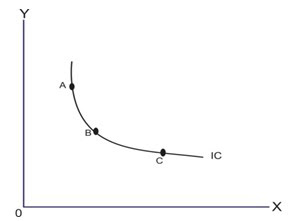HOUSEHOLD BEHAVIOR AND CONSUMER CHOICE
Matching Questions
1. The additional satisfaction gained by the consumption or the using of one more unit of something.
2. The limits imposed on household choices by income, wealth, and product prices.
3. Equating the ratio of marginal utility of a good to its price for all goods.
4. When the price of something falls, household unequivocally better off due to the improvement in well being, this causes the change in consumption of its good.
5. The things with the greatest value in use frequently have little or no value in exchange, and the things with the greatest value in exchange frequently have little or no value in use.
6. The satisfaction, or reward, a product yields relative to its alternatives.
7. The difference between the maximum amounts a person is willing to pay for a good and its current market price.
8. The change in price of one good cause a household to shift its purchasing pattern away from substitutes toward this good.
9. Set of points where each representing a combination of some amounts of two goods, that all yield the same amount of total utility.
10. The more of any one good consumed in a given period, the less satisfaction generated by consuming each additional unit of the same good.
A.Substitution effect F. Marginal utility
B. Utility G. Income Effect
C. Indifference curve H. Water-diamond paradox
D.Consumer surplus I. Law of diminishing marginal utility
E. Utility maximizing-rule J. Budget constraint
True-False
1. The change in price of other product will determine the household demand to moving along the demand curves.
2. Labor supply curve is a diagram that shows the quantity of labor supplied at different output rate.
3. When price of something we buy rises, we are worse off.
4. Substitution effect states that when wage increase, the leisure time will also increase.
5. The marginal utility comes from all units consumed.
6. The wage rate is the price of leisure.
7. The labor supply curves will slopes upward when the income effect outweighs the substitution effect.
8. MUx . Py = MUy . Px
9. As long as indifference curves are convex to the origin, utility maximization will take place at the point at which the difference curve is just tangent to the budget constraint.
10. The real cost of any good or service is its opportunity cost.
Multiple Choices
1. For normal goods, the income and substitution effect work at …..direction
a. Different
b. Same
c. Left
d. Right
2. The key assumption that we make to analyze the household behavior and consumer choice is that all markets are ….. which consist of……
a. Monopolistic; unique product
b. Monopolistic; differentiated product
c. Perfect competition; homogenous product
d. Perfect competition; heterogeneous product
3. The basic of choice is….
a. Utility
b. Price
c. Demand
d. Income
4. Marginal Rate of Substitution is equal to….
a. Py/Px
b. -MUx/MUy
c. -Px/Py
d. MUx/Px=MUy/Py
5. The labor supply curve slope is….. when …..
a. Upward; substitution effect smaller than income effect
b. Downward ; substitution effect greater than income effect
c. Upward; substitution effect greater than income effect
d. Downward ; substitution effect equal to income effect
6. Both income and substitution effect imply ……. relationship between price and quantity demanded.
a. Positive
b. Negative
c. Positive and negative
d. Uncertain
7. Slope of indifference curve is equal to…
a. Py/Px
b. -MUx/MUy
c. - Px/Py
d. MUx/Px=MUy/Py
8. The “backward-bending” supply curve happened when….
a. Substitution effect equal to income effect
b. Income effect outweighs the substitution effect
c. Substitution effect outweighs the income effect
d. Always
9. When price of steak is $5 and price of soft drink is $2 and Andy has $40 to spend, which one of following combinations is efficient for Andy:
a. 4 steaks and 5 soft drinks
b. 6 steaks and 4 soft drinks
c. 8 steaks
d. 21 soft drinks
10. Which one is the optimal point of indifference curve below :
a. A c. C
b. B d. no one
Essay
1. Explain the three ways of consumer response related to the ability to choose combinations of two goods/services available!
2. a. Define the budget constraint and write its equation!
b. Suppose the price of X is $3 and the price of Y is $8, and the household has $480 to spend per month on goods X and Y. Sketch the household budget constraint.
3. Which one of the following point should be chosen in order to consume efficiently? Why?
4. Explain about law of diminishing marginal utility.
5. What is MRS? What does the mean of MRS =5?
6. Explain about water-diamond paradox (paradox of value) !
7. Explain about substitution and income effect!
8. Fill in the blank of the data below :
| Slice of bread consumed | Total utility | Marginal Utility |
| 1 | 10 | …. |
| 2 | 20 | …. |
| 3 | 26 | …. |
| 4 | 30 | …. |
| 5 | 30 | …. |
a. Graph the total and marginal utility curves.
b. Are these preferences consistent with the law of diminishing marginal utility? When we should to stop consume more slice of bread?
9. Explain the income and substitution effect of wage increase. Draw the two possibilities of labor supply curves related with effect which dominates!
10. Derive the demand curve from indifference curve and the budget constraint!
CHAPTER 6




0 komentar:
Posting Komentar